Shrubs with Yellow Flowers many gardeners like to plant given that yellow is arguably the happiest colour; it makes sense that.
The vivid shade of yellow contrasts strikingly with nearly any background, particularly the rich greens of plant leaves and the brown tones of fences, branches, or mulch.
Are you having trouble selecting the ideal brightly coloured, yellow-blooming trees and shrubs to put in your yard or other areas of your house? This post has images and details on some of our favourite yellow-flowering trees and shrubs!
1. Oregon grape

Scientific name: Mahonia aquifolium
The Oregon grape, as it is aptly named, is the official flower of Oregon. Oregon grape bushes have year-round colourful foliage, including vivid yellow flowers, purple or blue fruit, and green and purple leaves. Remarkably, the fruit is edible and has an acidic flavour; it is not a grape.
Oregon grape trees thrive best in well-drained soil, which facilitates optimal growth. These trees grow best in full-sun locations with neutral to slightly acidic soil. To keep the soil healthy and moist, water the land frequently—at least once a week.
2. Pontic Azalea
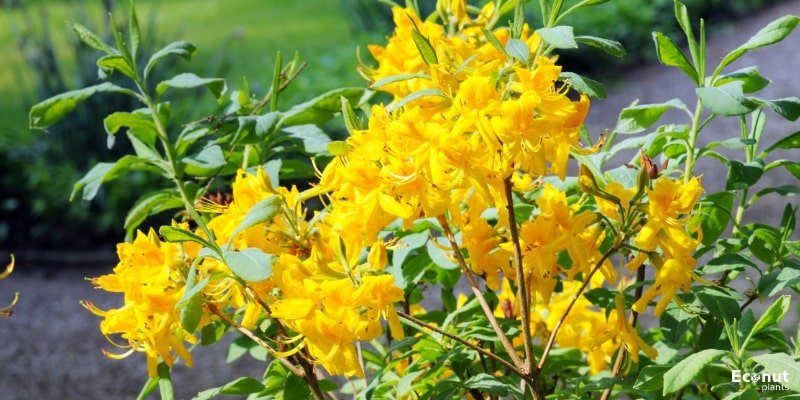
Scientific Name: Rhododendron luteum
Pontic azaleas, sometimes referred to as honeysuckle azaleas, are well-known for their fragrant springtime leaves and vibrant colour. It is a medium-sized, bushy shrub that bears bright yellow, funnel-shaped blooms in bunches.
Certain honeysuckles are poisonous, such as the Pontic Azalea, which is not edible. It has been suggested that yellow azaleas can stand for ties to one’s family or for friendship.
Rhododendrons grow well in cool, damp climates with lots of sunshine. For best health, plant them shallowly in a spot that shields them from high winds. Adding mulch every year will help the soil stay cool and retain moisture.
3. Tipu Tree
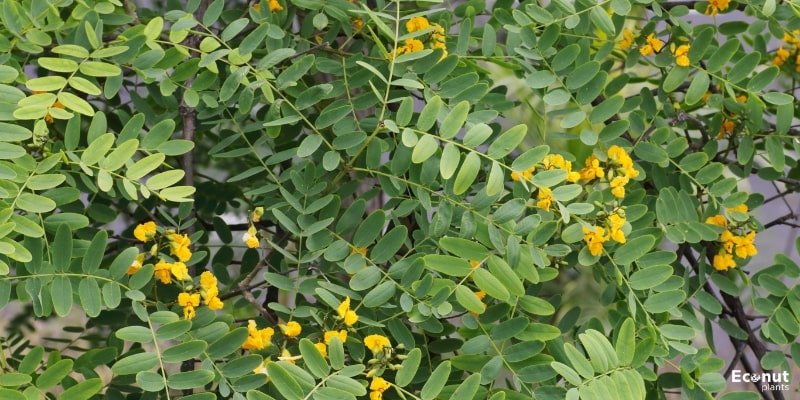
Scientific name: Tipuana tipu
Beautiful natural legume trees from Bolivia are called Tipu trees, or Tipuana trees. Large trees with a flat top that offer plenty of shade are called tippu trees. Their maximum growth is approximately 15-20 feet tall, and they grow rather swiftly. Before losing its leaves in the spring, this tree displays a canopy of vivid green foliage every winter.
Tipu trees grow well in most soil types, including sand, clay, and moist or dry soil. They grow best in acidic soil, but alkaline soil will also support their growth. Although moderately drought-resistant, tipu trees look best when they receive a lot of frequent irrigation.
4. Witch-Hazel
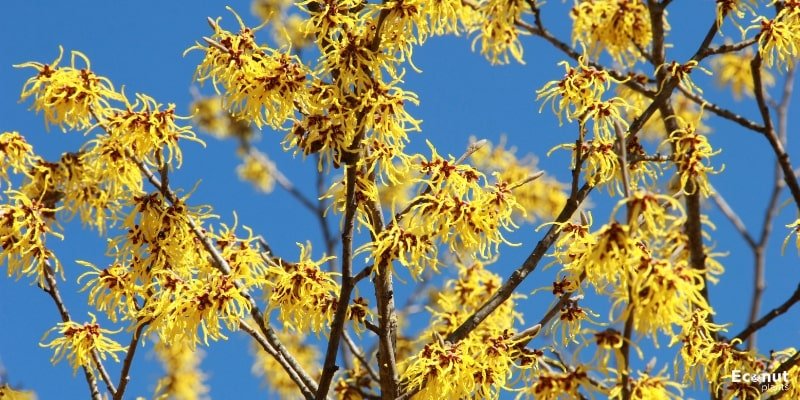
Scientific name: Hamamelis
Mid-autumn is when Witch-Hazel trees bloom, and their flowers are distinctive with pastel petals. Its branches grow upward, giving the appearance of an inverted triangle. Many gardeners cultivate witch hazel for its skin-care properties, which include relieving sunburn and insect bites.
These gorgeous trees reach a maximum height of thirty feet and a maximum width of fifteen feet at the top. Witch-Hazel trees are ornamental trees that can be used as borders and hedges.
Plant Witch Hazel in full sun or, in warmer climates, in half shade. They need to be watered frequently and thrive best in soil that is high in nutrients.
5. Yellow Camellia Shrub
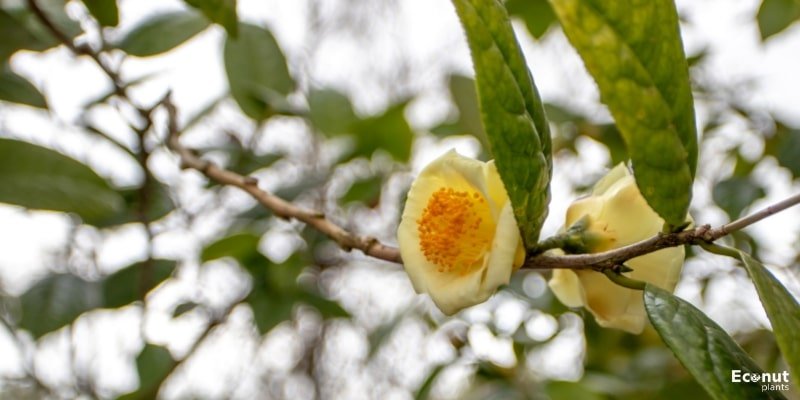
Scientific name: Camellia nitidissima
Beautiful pastel flowers with a creamy yellow hue and a hint of pink are produced by yellow camellia shrubs. Soon after the blossoms have fully bloomed, their colours intensify. Additionally, some Camellia shrub kinds have vivid yellow blossoms.
Grow camellias in broad sun or light shade in the spring or autumn, depending on the type. When they are younger, yellow camellia shrubs require some shade to shield them from intensely sunny days. Still, since they might not flower, you don’t want to plant these shrubs in completely shaded places.
As the plants get bigger, their foliage will protect the roots from the sun by providing shade. After planting, give the camellias regular watering throughout the growing season.
6. Yellow Oleander
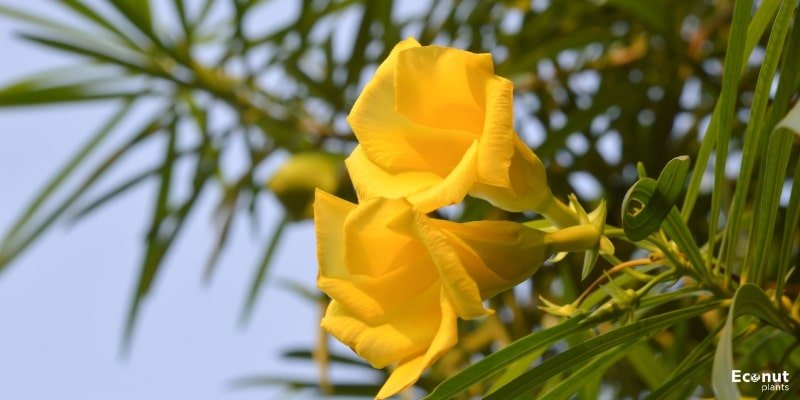
Scientific name: Cascabela thevetia
Bright yellow flowers adorn yellow oleander plants, which have slender green leaves and stems. This shrub is toxic while being a beautiful addition to your garden. Make sure to plant them in places where pets or young children can’t eat them by accident.
For this tall shrub to reach its maximum growth potential, it requires an open space. To maintain the lovely and healthy appearance of these plants, water them frequently from spring until autumn. Early blossoming might be shortened by dry soil.
Oleanders prefer moist conditions, so if you live in a dry area, shower them more often than once a week. For the best drainage and to promote strong roots, they need composted soil that has been well-drained.
7. Yellow Chain Tree
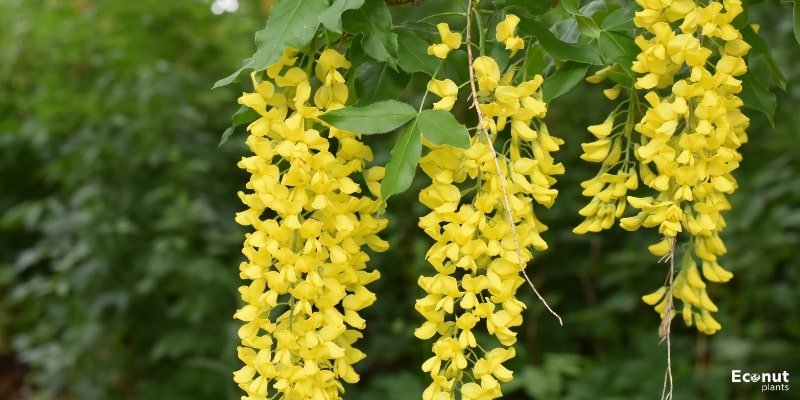
Scientific name: Laburnum
This magnificent tree produces brilliant, one-of-a-kind golden blossoms that hang in clusters up to 20 inches long, adding brightness and distinction to your garden. Be mindful of the perfume; it may take some getting used to their strong aroma. Stakes are necessary for young trees to sustain their trunks.
Sow golden chain trees in the autumn or early spring. Full sun and either acidic or alkaline, well-drained soil are ideal for the growth of these trees. At about two feet a year, they grow fairly swiftly. Weekly watering of your yellow chain trees is recommended, but do not puddle at the root.
8. Winter Jasmine
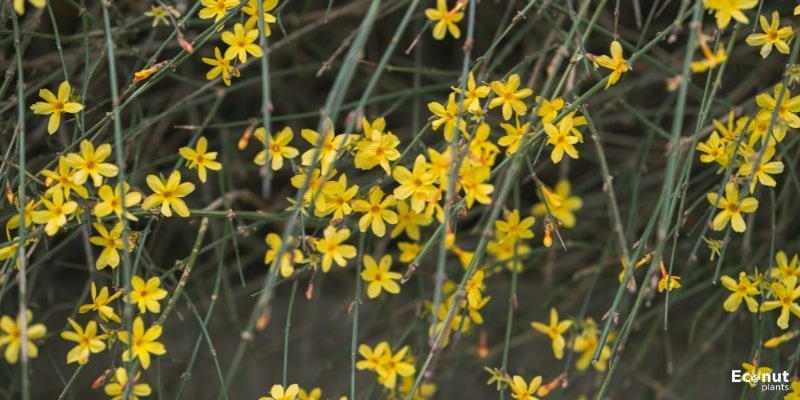
Scientific name: Jasminum nudiflorum
Winter jasmine’s yellow buttercup flowers, which bloom in the winter, could lead one to initially confuse it with Forsythia. The Chinese name for it is “Yingchun,” which means “the flower that welcomes spring,” because it blooms after the winter.
Well-drained soil in bright, full-sun locations is ideal for winter jasmine growth. It needs watering most frequently, two or three times a week, throughout the spring and summer. Watering should be cut back progressively to once a week in the autumn and winter.
9. Sweet Acacia

Scientific name: Vachellia farnesiana
Loved for its fragrant blossoms, Sweet Acacia is another evergreen. A shrub with a vase-like shape, it is semi-evergreen. During the spring, this striking shrub bears clusters of fuzzy yellow flowers.
To ensure optimal health, cultivate Sweet Acacia shrubs in full sun and warm, sunny locations. Watering these bushes heavily is necessary during the summer, especially during periods of excessive heat. If you provide ample water, you should anticipate optimal foliage and flowers.
10. Spindle Bush

Scientific name: Euonymus europaeus
A striking shrub with an eye-catching structure is the deciduous-evergreen Spindle Bush. Shrubs with euonymus blooms in the spring have yellow-green hues, and in the autumn, the fruit resembles fuschia and has scarlet seeds. With their striking, vibrant appearance, they make excellent decorative shrubs.
When exposed to direct sunlight, spindle bushes flourish and produce their most beautiful blooms. These bushes, however, can withstand some sun. They can adjust to any level of acidity and work with any type of soil. Up until they become established, these shrubs need to be watered often.
11. Palo Verde

Scientific name: Parkinsonia praecox
Palo Verde trees are stunning semi-evergreen trees with orange-centered, bright yellow flowers. The small blossoms cover the tree, creating a striking contrast with the branches and bluish-green foliage. Apart from the lovely blossoms, the trunk and branches themselves have a striking appearance.
Each branch has gracefully woven twists and turns as it grows, and the trunk boasts a characteristically smooth green bark. Except for the harsh winter months, you may cultivate Palo Verde trees almost year-round. Plant this tree in well-drained, deep soil; do not water it too much. Palo Verde trees only require biweekly watering in the summer and monthly watering in the winter.
12. Lydian Broom
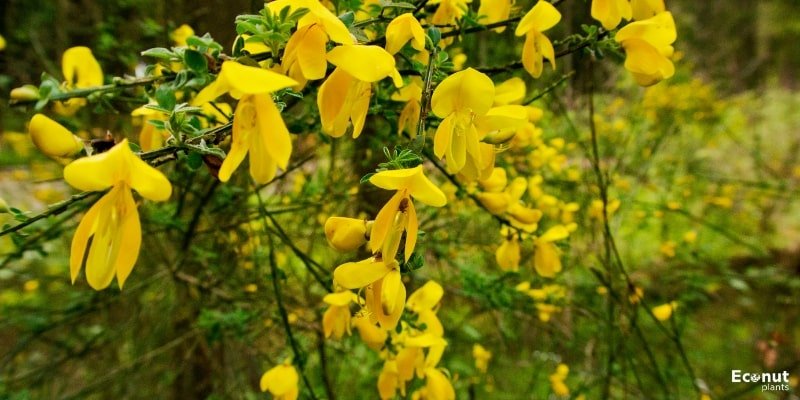
Scientific name: Genista Lydia
Small but brilliant yellow blooms bloom on lilyan broom shrubs, which have distinctive bluish-green leaves. If gardeners like to add yellow splashes to their gardens, these shrubs are perfect for that. When they reach maturity, they resemble spherical mounds.
These shrubs can be planted in nearly any type of soil since they can withstand varying degrees of acidity and poor soil. Fertilizer is rarely necessary for these plants because they are not picky. Until they become established, they need constant watering and full sun.
13. Kousa Dogwood
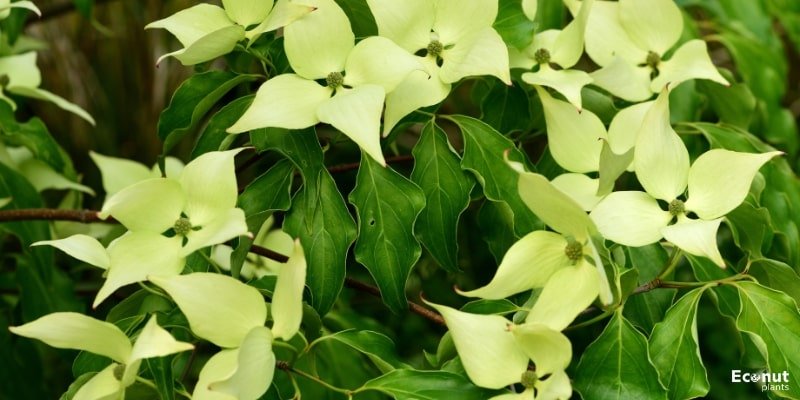
Scientific name: Cornus kousa
Kousa dogwood trees bloom in the spring with either white or pale yellow blossoms. Every autumn, the leaves become a vibrant reddish-purple hue. These trees have a broad canopy and grow to be quite tall. Compared to other dogwood trees, kousa dogwoods are typically more resistant to disease and insects.
Both full sun and some shade are ideal for kousa growth. Grow Kousa dogwoods in slightly acidic, nutrient-rich, well-drained soil. While established dogwoods can withstand times of excessive heat and dryness, they may benefit from a weekly watering. Once a week, please give them a good watering for optimal growth.
14. Golden Trumpet
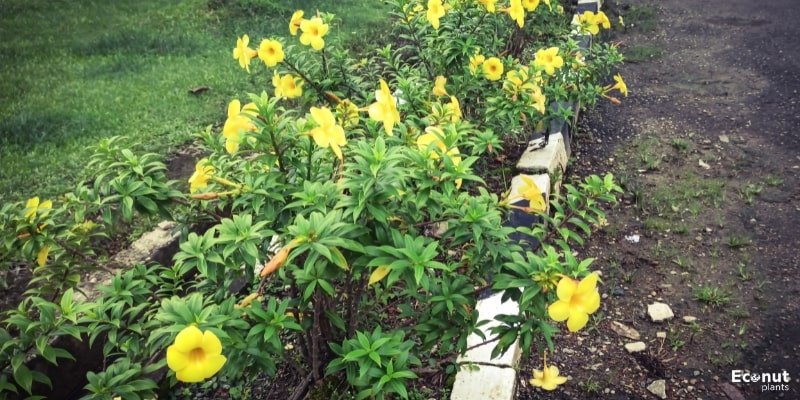
Scientific name: Allamanda cathartica
The round-canopied golden trumpet trees can reach heights of 25 feet or more. Originally from Brazil, it is a hybrid of Tabebuia ochracea and is semi-evergreen or semi-deciduous.
To enable Allamanda trees to flourish and fully blossom their stunning yellow flowers, avoid giving them excessive amounts of water. Sunlight, rich soil, and moderate irrigation are the ideal growing conditions for them.
In order to provide it with the nutrition it needs to flourish, fertilize every few weeks over the spring and summer. Fertilizer for Golden Trumpet trees can be discontinued as winter approaches.
15. Forsythia

Scientific name: Genus Forsythia
The deciduous shrub forsythia, sometimes referred to as the golden bell, is indigenous to Eastern Europe and East Asia. It is an excellent addition to any garden because it is a fast-growing, low-maintenance shrub. Bright yellow flowers grow in the spring on golden bell shrubs.
Make sure your forsythia receives at least six hours of sunlight each day. It may not flower properly in mild sunshine, but it can still survive. Well-drained soil is essential for these shrubs because soggy soil hinders proper growth.
16. Bush Cinquefoil
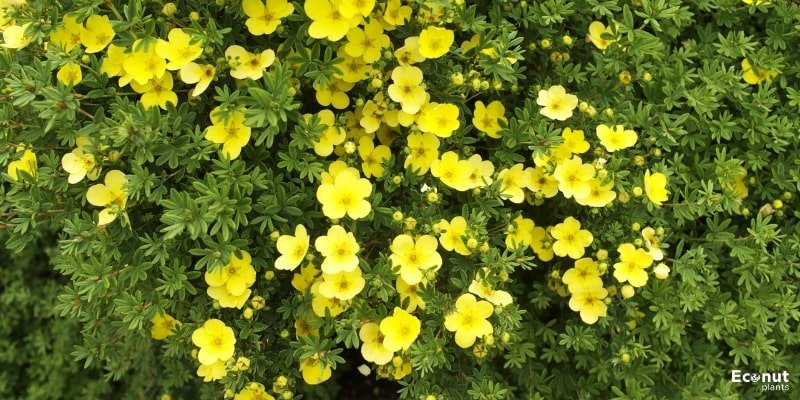
Scientific name: Potentilla fruticosa
Beautiful, bright yellow flowers bloom from summer to autumn on the bush cinquefoil shrub. Never let this stop you, though; it grows to a height of one to three feet. In regions as low as -50 degrees Fahrenheit, this plant can flourish if you reside in a cold climate. It is also simpler to maintain bush cinquefoil because of its excellent resilience to disease and insects.
Plantain leaves require full sun or light shade for optimal growth. The plant can bloom for a longer period of time on hot days if it has some shade. It can grow in clay, rocky, alkaline, or dry soil, but it prefers moist, well-drained soil.
17. Austrian Briar
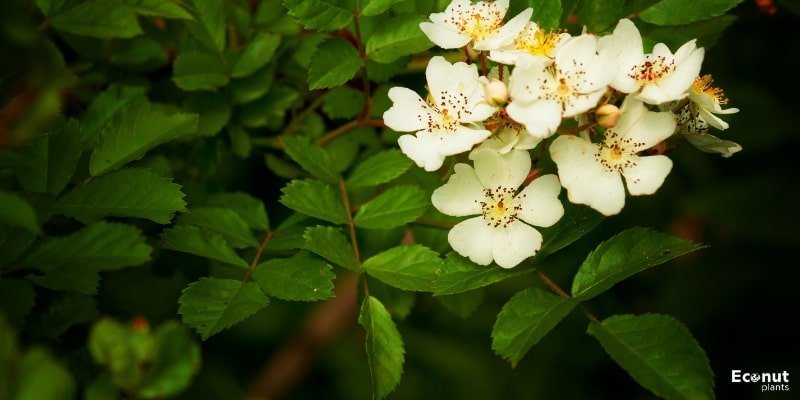
Scientific name: Rosa foetida
Early in the summer, Rose Foetida, also known as the Austrian Briar, will display gorgeous golden flowers. In addition to being eye-catching to us, the colour attracts birds, butterflies, and bees.
Austrian briars require full sun exposure throughout the day to maintain their health. A rose foetida grows well in moist soil, but make sure the soil isn’t too wet. To prevent overwatering and root rot, high-draining soil can be beneficial.
18. Chinese Flame Tree
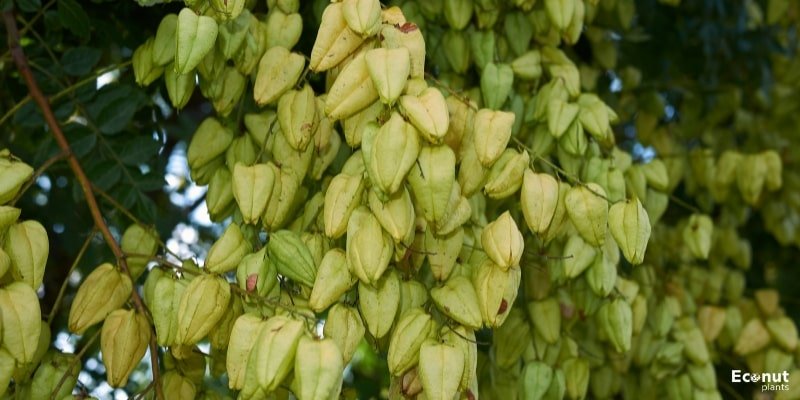
Scientific name: Koelreuteria bipinnata
The fragrant blossoms of the Chinese Flame Tree, commonly called the “Golden Rain Tree,” change colour from yellow to orange or red and have a lantern-like appearance. Any garden would benefit from this tree’s shadow, and you may even grow plants beneath it that like the cooler weather.
If this gorgeous tree is placed in an area that doesn’t receive enough sunshine, it could appear a little strange. Although they may grow in a variety of soil types, Chinese flame trees prefer well-drained soil. You’ll need to water it somewhat frequently for at least two to three years until it becomes established.
19. Golden Barberry
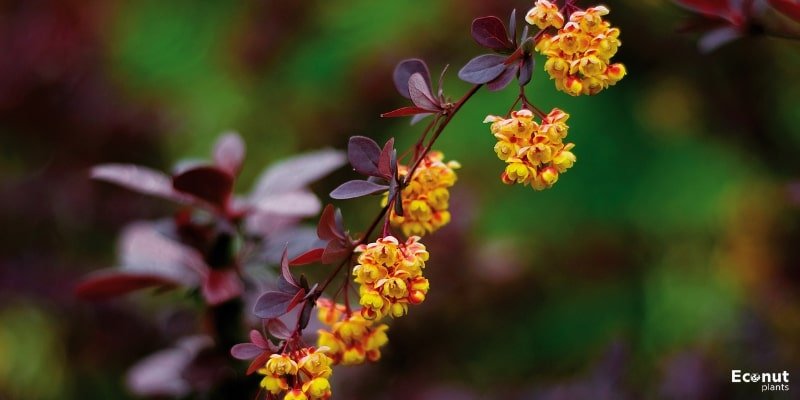
Scientific name: Berberis thunbergii
This gorgeous yellow foliage is produced year-round by the Japanese Barberry cultivar known as the Golden Barberry Bush. The leaves will turn a vivid red-orange as summer transitions into autumn, and they will eventually drop in the winter.
Watering the Golden Barberry frequently will be required until it becomes established. This shrub does not require plant feed, and it grows well in almost any kind of soil. It will be more of a lime colour than a brilliant yellow if it doesn’t receive enough sunlight.
20. Brazilian Plume Flower Shrub
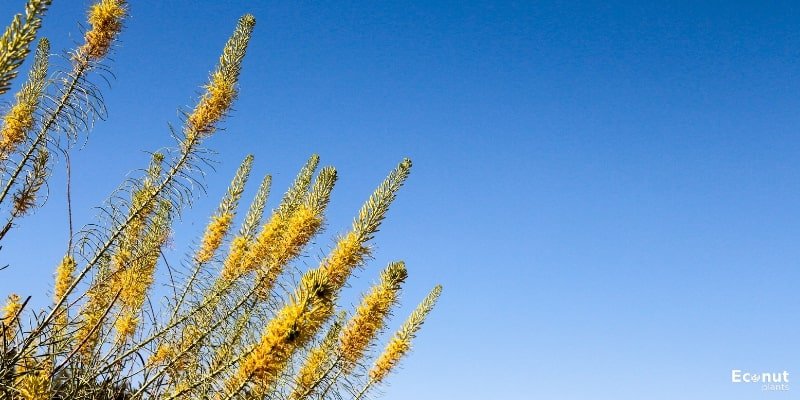
Scientific name: Justicia carnea
Evergreen Brazilian Plume Flower Shrubs have gorgeous tubular flowers and dark green foliage. Beginning in the early summer and lasting until the autumn, the Brazilian Plume blooms. These blooms attract a lot of butterflies and hummingbirds because of their form.
You must plant Justicia carnea in well-drained soil in a completely or somewhat shaded region if you want it to develop healthily. To encourage growth and blooms, fertilize this shrub in the early spring, midsummer, and early autumn.
21. Golden Jackpot
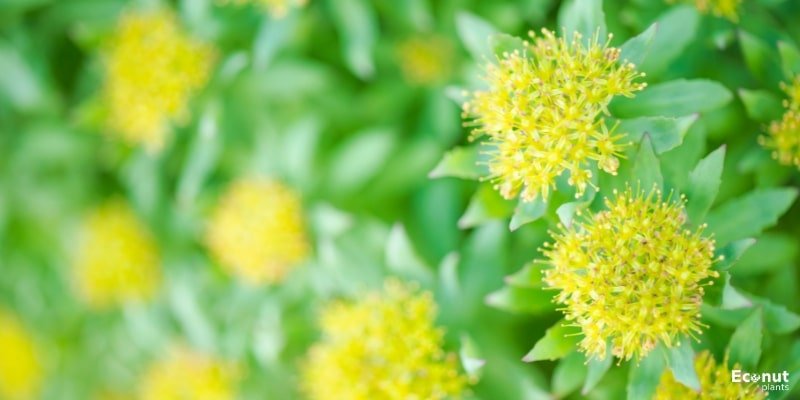
Scientific Name: Weigela rosea
Golden Jackpots are low-maintenance shrubs, commonly known as Weeping Weigelas. Throughout the summer, this plant produces brilliant yellow flowers with five petals. They form a stunning hedge and can reach heights of up to 6 feet.
A location with at least four hours of daily sunshine is ideal for growing weeping weigela. While the Golden Jackpot can be used on most types of soil, well-drained soil is ideal for it to function. Watering it frequently is required throughout its initial growing season and, in extremely hot weather, even more frequently.
22. Japanese Rose
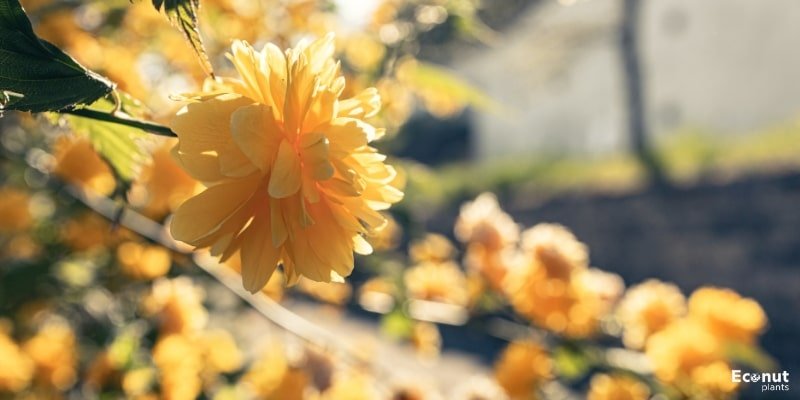
Scientific name: Kerria japonica
The Japanese rose is a deciduous shrub with vibrant yellow blooms that have five petals and vibrant green leaves that change to yellow in the autumn. The branches add visual interest to your garden in addition to the vivid and striking flowers.
It’s important to avoid overwatering Japanese roses, even though they need to be watered frequently. It struggles in wet soil, even if it can withstand periods of drought. In order to encourage flowering for the following season, Japanese rose plants must be pruned.
23. Honey Perfume Rose
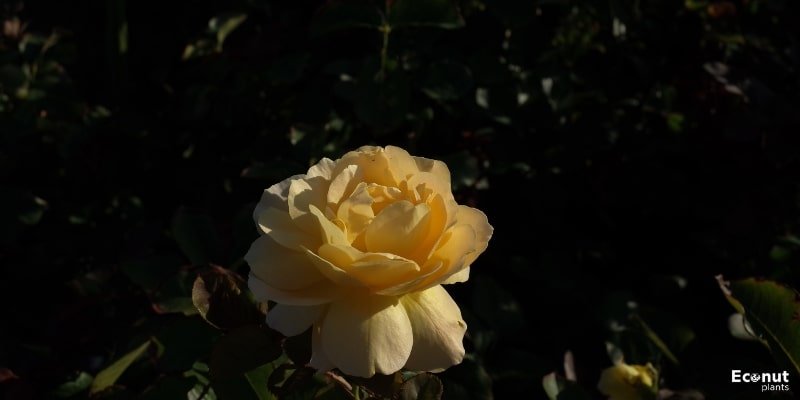
Scientific name: Rosa
The strong fragrance of Honey Perfume Rose bushes lives up to their name—they will fill your yard with the mouth-watering aroma of roses. There are Rosa plants that bloom in peach, apricot, and yellow hues.
These roses thrive in slightly acidic, well-drained soil with moderate watering. Rosa grows best in full sun and requires frequent trimming to maintain flowering throughout the growing season. Mulch can help keep weeds out while assisting the roots in retaining moisture.
24. Perforate St. John’s Wort
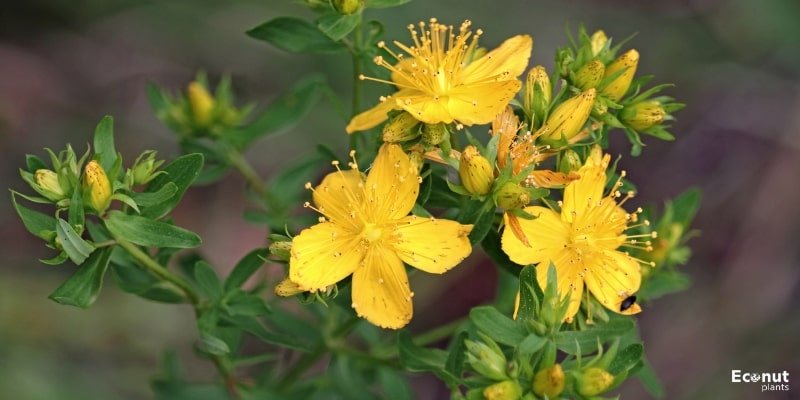
Scientific name: Hypericum perforatum
This striking shrub is covered in bright yellow blooms and has two-toned leaves. Being a perennial flower, it will bloom again next year. In the autumn, the green or blue-green foliage turns a yellowish-green hue. Each five-petaled yellow blossom has numerous stamens and microscopic black spots.
Although plants from the south prefer some shade, St. John’s Wort grows best in northern climates with lots of sunshine. No matter where you reside, it likes healthy, well-drained soil and regular watering. Composting once a year will promote the best possible growth.
25. Yellow Buckeye
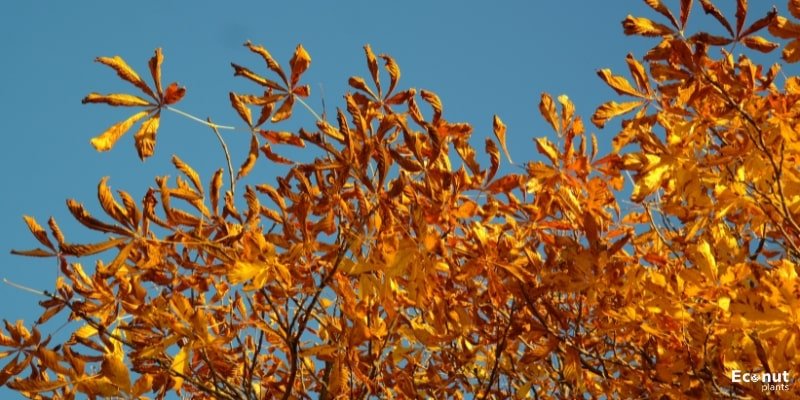
Scientific name: Aesculus flava
The oval-shaped yellow buckeye tree produces stunning fall foliage. Its leaves are dark green in the summer and become brilliant yellow and orange in the autumn. Pastels are the yellow blossoms from which the nuts are harvested. Remember that the yellow-coloured buckeyes on the tree are toxic.
These trees require lots of water and do best in locations with direct sunlight. For optimal results, grow yellow buckeyes in soil that is wet, well-drained, and somewhat acidic. Yellow Buckeyes are found in the soils found in the bottoms of coves and rivers, where they can withstand occasional floods. However, dry soil can completely ruin the foliage’s appearance.
Conclusion
Yellow is considered to be a more positive and happy colour than other hues. Therefore, it should come as no surprise that yellow flowers may bring cheer to your garden in addition to adding splashes of brilliant colour.
There’s probably something on this list that will grow in your hardiness zone because yellow flowers are found on so many different types of plants. Any one of these trees should offer some extra colour to your house or garden, even though we didn’t cover conspicuous yellow flowering plants like the cassia.
We recommend the Lydian Broom shrub if you like vivid yellow bursts. You just can’t go wrong with a Japanese rose for pastel flowers. The fragrant scent of Japanese rose plants permeates your yard as well. Happy planting and best of luck!

